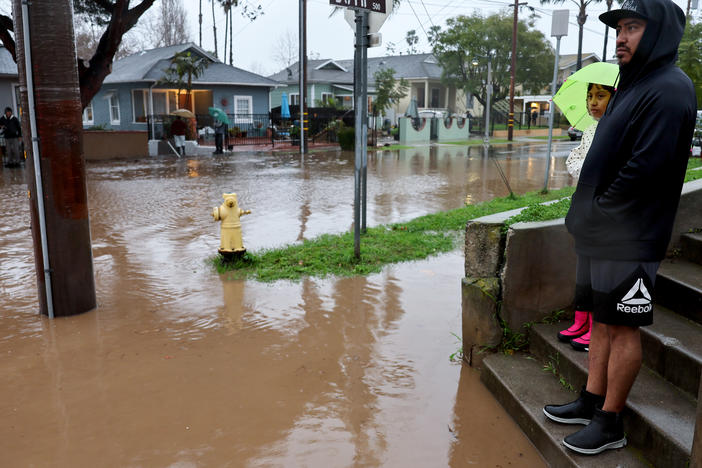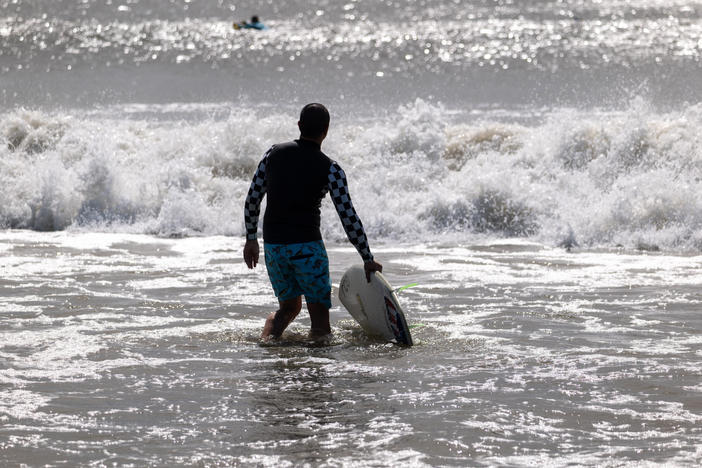Section Branding
Header Content
Glass Fire Rages Across Northern California, Burning Thousands Of Acres
Primary Content
Flames have engulfed nearly 50,000 acres of land, prompting the evacuation of more than 8,000 residents of Santa Rosa, Calif., according to Mayor Tom Schwedhelm.
Transcript
TONYA MOSLEY, HOST:
Fires continue to rage across Northern California this week, burning tens of thousands of acres. The Glass Fire in Sonoma and Napa counties has pushed people out of their homes, causing traffic jams in Santa Rosa, Sonoma County's most populous city. Police Chief Ray Navarro pleaded with people to keep the roads as clear as possible and only use them to leave.
(SOUNDBITE OF ARCHIVED RECORDING)
RAY NAVARRO: It is against the law to be in these evacuated areas, so do not go in there. We need to make sure it's safe for public safety to get to the fires.
MOSLEY: This is becoming a tragic routine for the area, and Santa Rosa Mayor Tom Schwedhelm said during a news conference, this isn't our first rodeo. He joins us to talk about it now.
Hello, Mayor, and welcome.
TOM SCHWEDHELM: Thank you for having me.
MOSLEY: Let's remind listeners what you were talking about when you said this isn't the first time Santa Rosa has dealt with dangerous fires there. There was the Tubbs Fire back in 2017, and you all learned a lot from those fires.
SCHWEDHELM: Well, actually, yes, we experienced fires in both 2017 with the Tubbs Fire - took out about 5% of our residential stock in Santa Rosa. And then in 2019, we had the Kincade Fire. About 60,000 of our residents were evacuated. We're actually getting better in our response to this. Traffic jams - we have bumper-to-bumper traffic as people were evacuating through the Glass Fire. But the good news is everyone got out safely, where unfortunately that wasn't the case back in the Tubbs Fire in 2017.
MOSLEY: Yes. It's good to know that this time around people have been able to get out safely. Can you tell us about the current evacuation orders in place now and the status of the fires right now?
SCHWEDHELM: So right now, we have approximately 8,200 folks who have been evacuated. There's about another 20,000 that are under evacuation warning. Because of the wind direction - it's been kind of laying low - most of the fires in San Rosa are out. But in our Trione-Annadel State Park, it is still burning, so it is still an active fire. It's still not 100% contained because as I drove through the burn area yesterday with our fire chief, you'll still see plenty of fire crews mopping up. You're seeing burning embers. And that's our greatest fear. If the wind picks up again and casts some of those burning embers, it could reignite.
MOSLEY: Help us understand containment, what that means for overall firefighting efforts.
SCHWEDHELM: Yeah. That was a learning experience for me also. Prior to getting on the city council, I worked for the Santa Rosa Police Department for 31 years. So I remember in 2019, went up in a helicopter to check the progress of the Kincade Fire, which at that time was 0% contained. I was expecting to see flames still there, but that wasn't what I saw. What we did see was smoke coming, and that's the biggest concern of firefighters.
Until there is no smoke, if the wind picks up, it's going to take those burning embers and throw them, you know, dependent upon the wind speed. In fact, this fire started as a spot fire from the Glass Fire in Napa. The wind carried it into Sonoma County, and then once it hit the brush, it started burning and quickly moving. It's not 100% contained until the fire professionals tell us, yes, the embers are out, and it's 100% contained.
MOSLEY: There are many communities now dealing with wildfires up and down the West Coast. And environmental experts say that this may get much worse due to climate change. What advice do you have for other areas where the fires might be reaching them for the first time?
SCHWEDHELM: Well, as far as climate change, you know, I would just say people need to take an active role in that. Don't pretend it's happening somewhere else and not here. City of Santa Rosa has that as one of our priorities, and we've taken several significant steps to try to lower our carbon footprint, if you will. But for those communities that have not experienced this - be prepared. We've done a lot of community education about having your go-bag ready. So if you do get the call that you have to evacuate, don't wait for someone else to take the responsibility for your safety.
In Santa Rosa, we've - since 2017, we send out maps. We've even sent postcards to all of our residents, so that they know their evacuation routes. Write them down. Know how to escape your neighborhood. When I had to evacuate my home in 2017, the fire was a couple blocks behind me. When we had to evacuate in 2019, we were much better prepared because we were warned, you know, an hour or two before it potentially could have come in our area. So be prepared.
MOSLEY: That's Santa Rosa Mayor Tom Schwedhelm.
Thank you so much for joining ALL THINGS CONSIDERED.
SCHWEDHELM: Thank you for having me. Transcript provided by NPR, Copyright NPR.
Bottom Content



